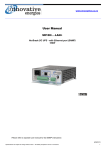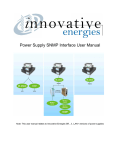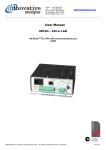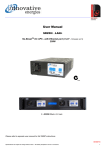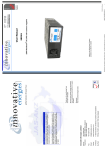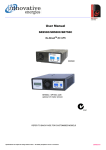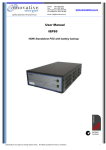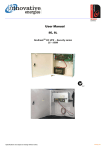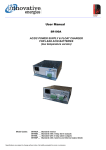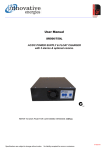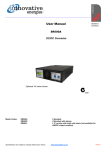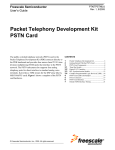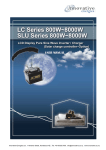Download SR100C: No-Break DC Charger (DC UPS)
Transcript
User Manual SR100C No-BreakTM DC UPS * Please refer to additional user manual for SR100i models with communications options. Label to be affixed here if battery condition test (BCT) enabled Specifications are subject to change without notice. No liability accepted for errors or omissions. 29/09/15 Safety The user is responsible for ensuring that input and output wiring segregation complies with local standards and that in the use of the equipment, access is confined to operators and service personnel. A low resistance earth connection is essential to ensure safety and additionally, satisfactory EMI suppression (see below). HAZARDOUS VOLTAGES EXIST WITHIN A POWER SUPPLY ENCLOSURE AND ANY REPAIRS MUST BE CARRIED OUT BY A QUALIFIED SERVICEPERSON. Electrical Strength Tests Components within the power supply responsible for providing the safety barrier between input and output are constructed to provide electrical isolation as required by the relevant standard. However EMI filtering components could be damaged as result of excessively long high voltage tests between input, output and ground. Please contact our technicians for advice regarding electric strength tests. Earth Leakage Where fitted, EMI suppression circuits cause earth leakage currents which may be to a maximum of 3.5mA. Ventilation High operating temperature is a major cause of power supply failures, for example, a 10oC rise in the operating temperature of a component will halve its expected life. Therefore always ensure that there is adequate ventilation for the equipment. Batteries in particular suffer shortened lifetimes if subjected to high ambient temperatures. Water / Dust Every effort must be made in the installation to minimise the risk of ingress of water or dust. Water will almost always cause instant failure. The effects of dust are slower in causing failure of electronic equipment but all electrical equipment should be cleaned free of any dust accumulation at regular intervals. Electromagnetic Interference (EMI) Switching power supplies and converters inherently generate electrical noise. All wiring should be as short as practicable and segregated from all equipment wiring which is sensitive to EMI. Residual noise can be reduced by looping DC wiring through ferrite cores (sleeves). These are most effective as close to the power supply as possible and as many turns of the wire taken through the core (+ and - in the same direction) as the core will accommodate. External fuse protection Fuses or circuit breakers must be used in all battery circuits to protect against short circuits. External fuses should be used for power supplies/ chargers even though they are usually internally protected. Connection polarity It is critical to check the polarity carefully when connecting DC devices. Some Innovative Energies models have nondestructive reverse polarity protection but usually a reverse polarity connection will result in a blown fuse or serious damage to the device. Glossary of terms used in our user manuals PSU = power supply unit BCT = battery condition test ECB = electronic circuit breaker ELVD = electronic low voltage disconnect RPP = reverse polarity protection EMI = electromagnetic interference SNMP = Simple Network Management Protocol LAN = local area network Specifications are subject to change without notice. No liability accepted for errors or omissions. 2 28/09/2015 INTRODUCTION The No-Break ™DC power supply is designed to provide DC power to lead acid batteries for critical back up applications. No-Break™ SYSTEM BLOCK DIAGRAM OPERATION OF ELECTRONIC CIRCUIT BREAKER (ECB) FOR PROTECTION OF BATTERY CIRCUIT & BATTERY Max. allowable load amps (x I rated) Max. allowable load amps (x I rated) INPUT POWER OFF 8 8 INPUT POWER ON Short circuit condition, ECB trips within 2ms Short circuit condition, ECB trips within 2ms 7x I rated for 300ms max. 7 6x I rated for 300ms max. 6 2.5 x I rated until battery fully discharged 1.5 x I rated until LV disconnect operates 2.5 1.5 2ms 300ms ECB automatically resets Time IPSU = 1x I rated IBAT = 1.5x I rated 2ms ECB trips & latches off until input power is restored 300ms Time IPSU = 0 IBAT = 1.5x I rated The ECB will operate on overcurrent as above & is also activated for the low voltage disconnect function on mains fail (no input power). It will reset when input power is restored, or can be manually reset by briefly shorting the BAT- and LOAD- terminals together when there is no input power. Specifications are subject to change without notice. No liability accepted for errors or omissions. 3 incl. SR100i Global Solutions Personal Focus Communication options available ♦ 24 Month Warranty High performance No-BreakTM DC UPS system Automatic battery condition test option Separate outputs for load and battery Battery detection - regular battery presence and battery circuit integrity checks Battery deep discharge protection ECB for battery overload & short circuit protection Reverse battery polarity protection Automatic temperature compensated output volts Power loss & battery system alarms No transition switching to backup battery LED flash codes for precise fault indication Optional communication interface allows remote monitoring & user control of BCT function - i versions SPECIFICATIONS All specifications are typical at nominal input, full load and at 20°C unless otherwise stated. ELECTRICAL No-Break™ FUNCTIONS AND ALARMS Battery charge current limit 100% of PSU rated current unless specified on ordering 88V- 132VAC 45-65Hz, Reverse polarity protection Battery reverse connection will open internal fuse (and produce alarm) Fusing / protection Input fuse & varistor Output fuse & ECB for battery circuit Battery monitoring Isolation 1KV DC input - output / earth Detects for presence of battery on start up, then every 60 minutes when charge current < 200mA Efficiency > 85% Inrush current <30A, 1.8ms Battery circuit protection - low battery volts Output power 100W Output voltage 13.8, 27.6, 34.5, 41.4, 55.2VDC Voltage adj. range 85 - 105% of Vout Electronic circuit breaker (ECB) operates under the following conditions: • battery voltage drops to 1.67V/cell auto reset on power on • < 300ms for I bat > 6 x I PSU rated , allows ~1.5x rated PSU current from battery without acting, • < 2ms, backed up by fuse Temp. compensation Temperature sensor on 1.7m lead with adhesive pad: -4mV / °C / cell ±10% LED indication Green: Power OK Green: Battery OK Current Limit PSU: 100% rated current Battery: 25-100% PSU current Alarms • • Input voltage ▪ standard 180V - 264VAC 45-65Hz ▪ optional Line regulation <0.04% over AC input range Load regulation <0.5% open circuit to 100% load Noise <0.3% Transient response 200mV over / undershoot, load step 20-100%, 400us settling time Thermal protection Yes, self-resetting Hold-up time 15 - 20 ms (nom. - max. Vin) without battery STANDARDS EMI Safety to CISPR 22 / EN55022 class A, C-tick compliance to IEC950 / EN60950 / AS/NZS3260 - overload - short circuit Alarm relay contacts Battery condition test (BCT) Power OK (Mains/PSU fail) Battery System OK - alarms when battery voltage low (on mains fail) , battery missing, battery circuit wiring faulty, BCT fail (if enabled) C - NO - NC full changeover rated 30VDC,2A /110VDC,0.3A/125VAC,0.5A Standard on SR100 i versions BCT relay contact provided to control an external test load. PHYSICAL AC input connector IEC320 input socket (similar to PCs etc.) DC connections Plug-in style socket & mating screw terminal block: (max. wire 2.5mm² / way) Alarm connections Plug in screw terminal block Enclosure Zinc plated & powder coated steel Dimensions 147W x 177D x 62H mm Weight 0.95 Kg Specifications are subject to change without notice. No liability accepted for errors or omissions. 4 100 Watt No-Break™ DC charger for lead acid batteries incl. SR100i STANDARD MODEL TABLE DC Output MODELS Output (V) PSU Rated (A) Charge Limit (A) *1 Recomm. Load (A) Peak load on power fail (A) SR100C12 13.8 7.5 7.5 6.0 11 SR100C24 27.6 3.7 3.7 3.0 5.5 SR100C30 34.5 2.9 2.9 2.3 4.3 SR100C36 41.4 2.4 2.4 1.9 3.6 SR100C48 55.2 1.9 1.9 1.5 2.8 SR100i with RS485 serial port ENVIRONMENTAL OPTIONS Operating temperature Standard: 0 to 50 °C ambient at full load Option - Low temp: -20 to 50 °C ambient at full load, add suffix -LT Battery Condition Test Add option SFMCT xxxxx on SR100C. Default setting 20mins/28 days. SR100i : default setting is scheduled BCT disabled at start up De-rate linearly >50 °C to 0 load @ 70 °C Storage temperature -20 to 85 °C ambient Humidity 0 - 95% relative humidity non-condensing Cooling Natural convection Communication Port for -i & V versions Choice of RS485, RS232, LAN+ (SNMP), LAN (ASCII) Modbus converter For SR100i ( 485, use protocol converter, with programming port for PC. Power MBLink setup software supplied. add +PROTOCONMB or add +PROTOCONMB-OE with ethernet port *1 Charge current limit 25% & 50% settings available SCHEMATIC BLOCK DIAGRAM CABINET OPTIONS 19”Rack Mount Wall Mount Enclosure 2U sub rack option: add SR-RM2U Optional V/I meter for subrack: SR-METER PSU may be fitted into enclosure with MCBs and terminals: add SEC-SR ACCESSORIES SUPPLIED Mounting feet together with screws AC power cord 1.5m with IEC320 socket & AUS/NZ plug Mating screw terminal plug for DC output Mating screw terminal plug for alarms MODEL CODING AND SELECTION CHART Optional Communications Interface Port For SR100i versions: 485 = RS485 232 = RS232 LAN+ = Ethernet (SNMP) LAN = Ethernet (ASCII) Input voltage and front panel standby switch Blank = 230V AC no switch G = 110V AC no switch J = 88-135VDC no switch Output DC connector X = Plug in /screw terminal block Temperature Compensation T = Yes DC output (nominal battery voltage) 12, 24, 30, 36, 48V Function C = No-Break™ DC PSU/charger i = C with serial or ethernet communications port Power 100W Specifications are subject to change without notice. No liability accepted for errors or omissions. Blank = No 5 CONNECTION DIAGRAM CONNECTION & INITIAL TESTING 1 Check input and output voltages of system, ensure that they match the equipment. All loads should be isolated. 2 Check polarity of all wiring. Place temperature sensor probe near or on batteries. 3 Plug in ac input and turn power on. Both LEDs will light up after approx. 4 sec, “BATTERY OK” LED will go out after another 10 secs (since there is no battery connected). DC output voltage should appear at both load and battery outputs (ensure screws are tightened down on the connector block). 4 Turn off input power. 5 Connect battery. 6 Check that ELCB (internal electronic circuit breaker) closes by shorting together the BATTERY –ve and LOAD –ve terminals for about 2-3 sec. You will hear a relay operate and both LEDs will light up. If this does not happen, there is a fault in the wiring or the internal battery protection fuse is ruptured (see Note 2 below). The battery voltage will then appear at the load terminals and the “BATTERY OK” relay energises. The “POWER OK” LED stays on for about 30 seconds. 7 Connect load wiring to LOAD+ and LOAD- terminals. 8 Turn on ac power. 9 After the batteries are fully charged, check that the battery continues to power up the load when the input power is turned off. NOTES 1 Fuse Ratings Fuse ratings should be calculated based on the load requirements. Note that the system is capable of allowing 2.5 x I PSU rated when mains power is on and 1.5 x I PSU rated when running off the battery only. 2 Reverse polarity protection If the battery is connected in reverse, the internal battery protection fuse may be ruptured and the unit should be returned to the manufacturer for repair. If the fuse is good, the voltage measured as at step 3 above should be exactly the same on both the load and battery outputs. Specifications are subject to change without notice. No liability accepted for errors or omissions. 6 ALARM CONNECTIONS Relay contacts shown in de-energised state (ie when there is a fault condition). Alarm relays are energised when system is operating normally. POWER OK AC INPUT BATT OK ALARMS POWER NC NO COM DC OUTPUT BATT LOW NC NO COM OO O Temperature sensor to be placed on or near battery + - + - ALARMS POWER: Loss of mains input power NOTE: This alarm has 30 second delay before activation upon mains failure. BATTERY LOW: 1. battery voltage = 1.8V/cell (for 2V cells) - operates only when no mains power present. 2. battery missing or fault in battery circuit wiring (alarm does not activate for up to battery detection interval time). LED INDICATION Power OK LED Battery OK LED Power Alarm Battery Low Alarm Normal Normal System Normal: AC power is on, PSU output is OK, battery circuit is OK and battery voltage is > V Battery Low. Normal Normal Battery detection test imminent (LED begins flashing prior to test ). Condition System AC power is on, PSU output is OK but either: Normal Alarm 1. 2. LEGEND : Internal battery fuse has opened (only if battery has been reverse polarity connected), or Battery circuit open - battery missing, or fuse / circuit breaker / wiring fault. Alarm Normal Either AC power has failed, or PSU has failed. Battery system is OK Alarm Alarm AC Power is off / DC has failed and battery has discharged to < V Battery Low, unit will continue delivering battery current until low level initiates ELVD. Alarm Alarm AC Power is off / DC has failed and ELVD has activated and disconnected battery from load. Residual current drain on battery following ELVD <1 mA. Normal Normal Battery Condition Test is in progress: LEDs flash alternately Normal Alarm Battery Condition Unserviceable: failed to maintain terminal voltage during battery condition test =On =Flashing =Flashing Slowly =Off Please note that the last three conditions apply only if the battery condition test option is enabled. Specifications are subject to change without notice. No liability accepted for errors or omissions. 7 Parameter V nominal Actual settings if different from default Default Settings 12 24 30 36 48 13.8 27.6 34.5 41.4 55.2 60 60 60 60 60 Vpres: 12.2 24.4 30.5 36.6 48.8 Vbatl: 11 22 27.5 33 44 Vshutd: 11.5 23 28.7 34.5 46 Vdisco: 10 20 25 30 40 Bccl (%) 100 100 100 100 100 Comms M M M M M BCTim (mins) 20 20 20 20 20 CC Mins: 40 40 40 40 40 CC Hrs: 23 23 23 23 23 CC Days: 27 27 27 27 27 MfiBCT: 30 30 30 30 30 V output (20°C) BatDetect (mins) BatDetect: Time between battery detections Vpres: Voltage threshold for battery detection and BCT. Note that if the voltage drops to this level during a BCT the test is aborted and the BAT LOW alarm shows. Vshutd: Internal voltage level of the power supply during battery detection and battery condition tests. Vbatl: BAT LOW alarm voltage level Vdisco: Voltage at which the load is disconnected from the battery during mains fail Bccl: Battery charge current limit as percentage of the rated power supply current Comms Communication mode of PSU: F = continuous data stream of status M = responds only to request made by a controller BCTim: Length of battery condition test CC Mins: Time in minutes between automatically scheduled BCTs CC Hrs: Time in hours between automatically scheduled BCTs CC Days: Time in days between automatically scheduled BCTs Note: The total time interval between battery condition tests (BCTs) is the sum total of the three 'CC' settings Time in minutes before the mains fail check during the BCT (only applicable to SR100) MFiBCT: Scheduled BCT disabled SNMP VERSIONS ONLY: Alarm mask 1048187 DHCP enabled Specifications are subject to change without notice. No liability accepted for errors or omissions. 8 These charts are system status diagrams showing current flows, alarm status & LED indication status for each state Specifications are subject to change without notice. No liability accepted for errors or omissions. 9 #1. 1 x No-Break™DC charger and 1 x battery bank #2. Peak load connection using 1 x No-Break™DC charger This is the basic connection which is most commonly used, and provides adequate protection for the majority of systems requiring DC back up in the event of a mains power failure. Use this connection when there is a connected load with a peak current likely to exceed 1.5 times the rated current of the charger. Standing loads are connected normally and an optional external low voltage disconnect may be used for the peak load. Alarms Available Single battery DC backup system Power OK YES Battery Missing YES Battery Low YES Battery Condition Test Fail YES Alarms Available DC backup for loads with high peaks *1 provided peak loads have no standing load component #3. N+1 of two complete No-Break™DC systems with each one capable of supplying the load YES Power OK Battery Missing * 1 YES Battery Low YES Battery Condition Test Fail YES #4 N+1 connection for peak loads using two complete No-Break™DC systems with each one capable of supplying the loads NEGATIVE COMMON Alarms Available N+1 redundancy for critical applications Alarms available Power OK YES Battery Missing YES Battery Low YES Battery Condition Test Fail YES N+1 redundancy with peak loads 1 * provided peak loads have Power OK YES Battery missing *1 YES Battery low YES Battery condition test fail YES no standing load component Specifications are subject to change without notice. No liability accepted for errors or omissions. 10 No-Break DC connections (continued) #5. N+1 of two complete No-Break™DC systems with each one capable of supplying the load #6 1 x No-Break™DC charger and 2 x battery banks The SR250xxxV No-Break™DC UPS is designed to provide superior battery backup availability without having to use two power supplies. Dual battery banks and automatic battery condition testing reduce the risk of battery failure for critical applications. POSITIVE COMMON Alarms Available Alarms available For mission critical applications *1 interlock circuit required for automated BCT Power OK YES Battery missing NO Battery low YES 1 Battery condition test fail* Enables more accurate testing of battery condition YES Specifications are subject to change without notice. No liability accepted for errors or omissions. Power OK YES Battery Missing (B1&B2) YES Battery Low (B1&B2) YES Battery Condition Test Fail (B1 & B2) YES 11 TERMS OF WARRANTY Innovative Energies Ltd warrants its power supplies for 24 months (two years) from date of shipment against material and workmanship defects. Innovative Energies' liability under this warranty is limited to the replacement or repair of the defective product as long as the product has not been damaged through misapplication, negligence, or unauthorized modification or repair. Thank you for purchasing from Innovative Energies. We trust your power supply will exceed your expectations and perform for years to follow. Sincerely, The Innovative Energies team. Innovative Energies Limited Phone: +64 9 835 0700 Freephone: 0800 654 668 (New Zealand) 1800 148 494 (Australia) Fax: +64 9 837 3446 Email: [email protected] Online: www.innovative.co.nz In Person: 1 Heremai Street, Henderson, Auckland, New Zealand By Post: PO Box 19-501, Auckland 1746, New Zealand Specifications are subject to change without notice. No liability accepted for errors or omissions. 12














